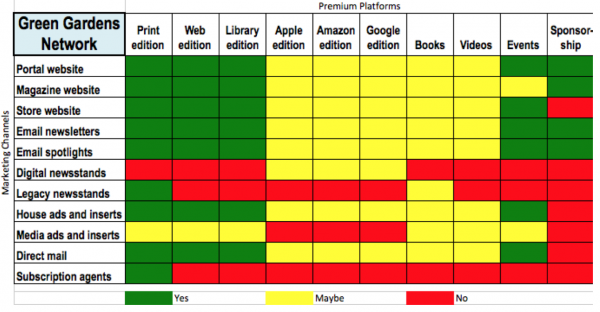Get your ducks in a row and plan your multiplatform publishing future
If you’ve considered selling your publication, the market is saying they will not value a publication at all if they are not at least on the road to multiplatform publishing – so if your organization is not on this path, then there may be no willing buyers until you are on this path.
The consumers are saying the same thing with their wallets – as multiplatform publishers are knocking revenues out of the park with new online and offline products.
However, the market values different media companies in different ways. Legacy print publishers are selling their companies and getting a 1-2x their EBITDA (Earnings Before Interest, Taxes, Depreciation and Amortization), while others cannot find a buyer. As they approach break-even or begin to spiral into the red, they just shut down because they do not want to take on such a major transformation – that which requires investing significant sums of money immediately.
However, if you are a multiplatform publisher, we are seeing our clients and others selling for up to 12x their earnings, sometimes 20x their earnings if they are both multiplatform and consistently growing their revenues.
This is what you’ll hear: “I’ll give you 10x revenue if it’s solid and stable, 20x if it’s doubling its revenue every year.”
When we work with magazine publishers – both legacy and digital natives, we create a business plan that can include a chart we call the Mequoda Multiplatform Media Matrix. We do this in order to identify what opportunities exist for their brand, and also which platforms should be prioritized.
The Mequoda Multiplatform Media Matrix
Across the top, you’ll see various kinds of premium platforms. There can be others too, depending on your business. For example, data could be a platform if you have a directory. Down the left side are the different marketing channels.

The Mequoda Multiplatform Media Matrix is all one big way of figuring out where your opportunities exist.
The way to read the Matrix is by taking one column and reading it downward.
We coded it green, yellow and red—like a traffic light—to identify which ones we see as easy, and which ones are more difficult to expand.
For example, in the matrix above we’re using our composite case study Green Gardens Network. This composite publishing network, which we use to teach the Mequoda Method at our Intensives, consists of a print magazine, a web and library edition of that magazine, plus an Apple, Amazon and Google edition of their magazine, along with books and videos. The company also produces live Events (tours) and generates Sponsorship Revenue. Then along the left hand side, you see all the marketing channels this publisher actively uses to promote their premium products.
In the same way, we wouldn’t sell a web edition, or Apple, Amazon and Google editions through legacy newsstands. If you’re wondering why the Apple edition is the only edition that is marked green for sale through a store website, it’s because many publishers sell their Apple edition through their websites, not just the newsstand.
The Mequoda Multiplatform Media Matrix represents what opportunities exist so that you can plan for the future. If no product exists, or if we don’t plan on creating one, it would not be on the grid.
For more elaboration, I’ll explain each of these marketing channels:
Portal Website: It is a Mequoda best practice to build a portal for every subscription website we create. Portals are intended to build and feed an audience; they are specially designed for SEO, email marketing, list building, and lead generation. More about portals.
Magazine Website: A magazine subscription site archetype is set up to build subscriptions for a related print or digital magazine and to provide access to issues of the magazine. A magazine site is only a magazine website if the user can view or download an issue of a magazine—one that is linear and periodic, has pages and a regular frequency, and can be viewed in HTML, downloaded as a PDF or downloaded to a mobile device. More about magazine websites.
Store Website: A cart-based store like Amazon offers many products for sale and uses a shopping cart for checkout. An event-based store like Farm Progress Show sells one or many events, but may also have many different price / package tiers or number of attendees. A single event-based store uses a solo order flow instead of a cart system.
Email Newsletters: Another Mequoda best practice is to maintain and publish a daily email newsletter, with a soft promotion for a featured product that’s aligned with the content. More about tightly aligned email newsletters.
Email Spotlights: In addition to email newsletters, email spotlights are promotions that highlight and feature just one product – so in the case of the Media Matrix – it’s whichever platform you are currently promoting. More about spotlight emails.
Digital Newsstands: Your Apple, Amazon and Google editions can be promoted through the Apple App Store, Kindle Newsstand, and the Google Play store. More about digital newsstands.
Legacy Newsstands: In print, your magazine is promoted on the physical newsstand – where the majority of single copy sales are made.
House Ads & Inserts: At little or no cost, you can promote your products through internal publications and ads.
Media Ads & Inserts: Or, you can pay to promote them through outside publications, radio, etc.
Direct Mail: Traditionally, you can use your list or buy a list to send physical direct mail.
Subscription Agents: This promotional strategy only applies to your print editions. This would be a third party agent that sells your subscriptions.
Have you begun planning your multiplatform future? The market is rewarding companies that are moving to a multiplatform publishing stance and can grow their earnings on a year over year basis. There’s a publishing renaissance going on as the magazine industry begins to see what their brands can be when they expand into multiplatform publishing.